THEY'RE middle of the pack one season, stars the next.
From Gary Ablett to Robbie Gray, here are eight of the most spectacular leaps into the football stratosphere.
Gary Ablett, 2007
From forward pocket to the game's most dangerous midfielder in the space of 12 months. In a year where he turned 23 and celebrated premiership success, Ablett realised his potential with his first of eight All Australian gongs.
Ablett was voted by his peers and the competition's coaches as the most valuable player in the AFL in 2007 after a career-defining assessment of his standing in the game by teammates in 2006.
Gary Ablett wasn't always the little master, but in 2007 all that changed. All pictures: AFL Photos 261.jpg)
Pipped by teammate Jimmy Bartel for the Brownlow Medal, Ablett was a runaway winner in the club's best and fairest before going onto claim the game's highest individual honour two seasons later.
In his first 79 AFL games, Ablett had never once topped 27 disposals in a game. In 2007, he did it in 12 of 25 matches. While he wasn't as damaging on the scoreboard, he was still one of seven Cats to manage 30 goals for the season as one of modern footy's greatest empires was born. - Mitch Cleary
| Season | Disposals | Inside 50s | Clearances | Rebound 50s |
| 2006 | 16.9 | 3.3 | 1.6 | 0.4 |
| 2007 | 26.7 | 5.9 | 4.0 | 2.1 |
Ablett, left, with younger brother Nathan and their 2007 premiership spoils. 1981.jpg)
Clayton Oliver, 2017
There was a strong hint in Oliver's maiden 2016 season – after a dramatic rise in the draft order to No.4 a year earlier – that he was going to be a special player. However, the Demon's ascension from promising young talent with a few ragged edges to borderline All Australian by his second season was remarkable.
Only Tom Mitchell, Gary Ablett and Matt Crouch averaged more disposals than Oliver in his breakout year, while Patrick Dangerfield was the sole player to rack up more contested possessions. There was a legitimate case for Oliver, the prototypical AFL midfielder these days at 187cm, to be shortlisted for All Australian honours in 2017.
Clayton Oliver was unlucky not to earn an All Australian blazer in only his second season.
The then-20-year-old's consistency shone through in the fact he amassed no fewer than 24 touches in any match. Oliver led the League in handballs (averaging 21.9) – even developing a unique way of feeding the ball out of congestion. He was also 10th in clearances (avg 6.6) and 11th in tackles (6.9).
His disposal efficiency of 77.1 per cent also ranked second among the top-10 ball-winners and fourth in the top 20. Regardless of the All Australian snub, Oliver has positioned himself as a key plank in any future Melbourne success. – Marc McGowan
| Season | Disposals | Clearances | Contested possessions | Tackles |
| 2016 | 19.2 | 4.1 | 9.5 | 4.8 |
| 2017 | 29.9 | 6.6 | 15.6 | 6.9 |
BEST OF 2018 The season's top 10 breakout stars
Jason Akermanis, 1999
The Queensland showman had displayed plenty of promise in 72 games across his first four seasons, but the arrival of Leigh Matthews as coach led to a dramatic rise for both player and club.
Akermanis had spent most of the first part of his career as a small forward who could play midfield. He kicked 76 goals in those games, but Matthews' arrival resulted in a shift to defence – and what a shift it turned out to be. Blessed with blinding pace, the then 22-year-old added a new dimension to Brisbane's defence. He was given the license to run-and-carry and that's just what he did, helping to take the Lions from the wooden spoon to a preliminary final.
Akermanis began as a flamboyant forward, but a shift to defence ignited his career. 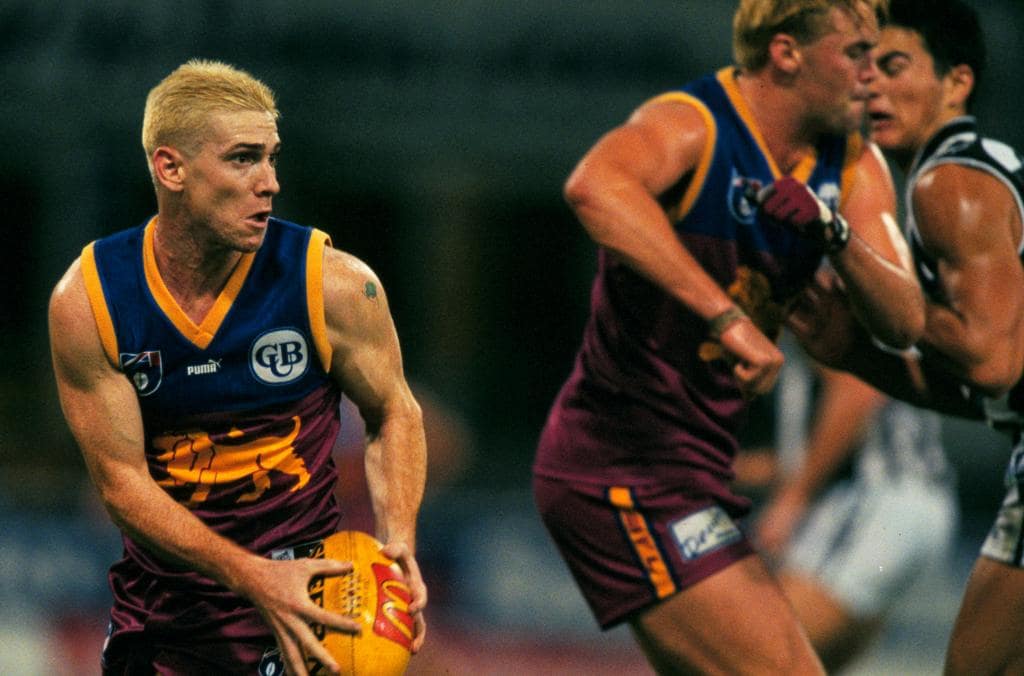
Akermanis averaged almost 20 disposals and earned his first All Australian selection in a back pocket, alongside teammate Justin Leppitsch. He would go on to win a Brownlow Medal two years later as a midfielder and be an integral member of Brisbane's three-peat of premierships from 2001-2003. - Michael Whiting
Aker lets rip a signature handstand in front of a packed Gabba.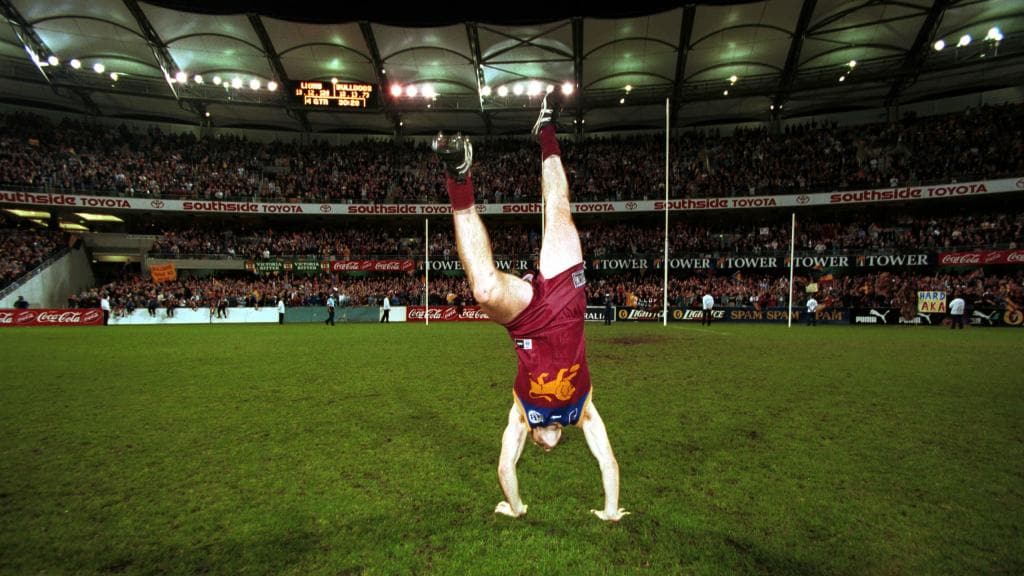
| Season | Disposals | Marks | Tackles |
| 1998 | 16.6 | 3 | 1.1 |
| 1999 | 19.5 | 4.4 | 1.5 |
Jeremy McGovern, 2015
It is incredible to think that at the end of 2013, the now three-time All Australian defender was sent away from pre-season training for being out of shape. Yet to play a game after being drafted as a rookie in late 2010, McGovern was told to shape up by new coach Adam Simpson and his fledgling career was in the balance.
McGovern leaves Hawk Jarryd Roughead trailing in his dust during his breakout season.
Now the 26-year-old looks back at that moment as his turning point at the Eagles. McGovern always had talent, but Simpson's tough love hammered home that ability alone wasn't going to be enough. He lost 10kg, started living like a professional athlete and was rewarded with a debut in round six, 2014. Initially used as a swingman in 13 games that year, McGovern realised his potential amid a defensive crisis for West Coast. When key backman Mitch Brown followed club champion Eric Mackenzie by going down with an ACL rupture in round one, 2015, it fell on McGovern to step up, and the 195cm defender answered the call.
Part of the famed 'Weagles Web', he played a key role as an intercept marking specialist as the Eagles defied expectations to make the Grand Final. It didn't end well in a 46-point belting from Hawthorn, but McGovern had emerged as a star and made the All Australian 40-man squad for the first time. – Travis King
'Gov' rises above the pack in the 2015 Toyota AFL Grand Final. 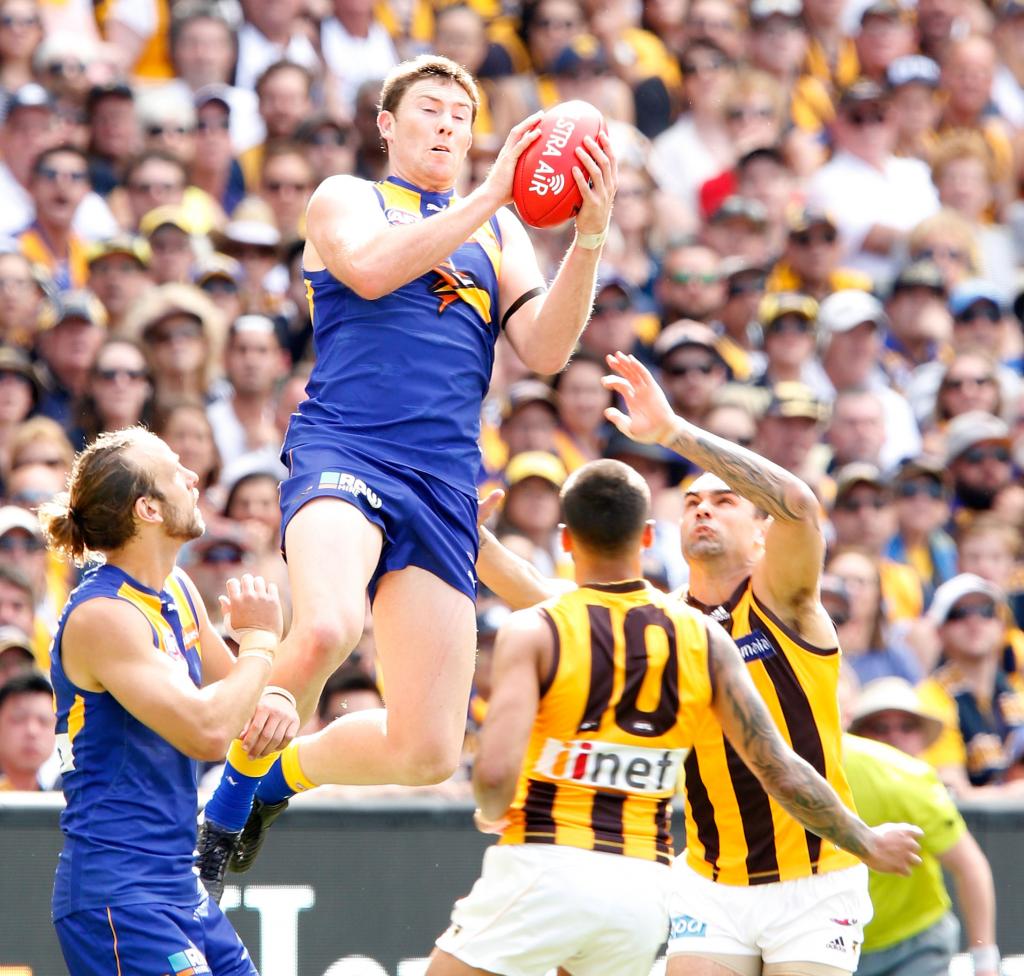
| Season | Games | Avg disposals | Goals | Avg contested marks |
| 2014 | 13 | 12.3 | 13 | 2.3 |
| 2015 | 20 | 13.5 | 3 | 1.4 |
Toby Greene, 2016
He was one of Greater Western Sydney's prime ball-winners when it entered the competition in 2012, and averaged over 28 possessions per game in two of his first three seasons, but it was a switch made by senior coach Leon Cameron at the start of 2016 that saw Greene become a star.
The free-wheeling midfielder was used as a high half-forward and relished his new role, using his supreme footy smarts to out-think his opponents up the ground, while also beating them in one-on-one battles inside 50. Greene kicked 44.28 and led the competition for inside 50s on his way to his first club champion award and Virgin Australia AFL All Australian selection.
Like Akermanis, a positional shift proved the difference between good and great for Toby Greene.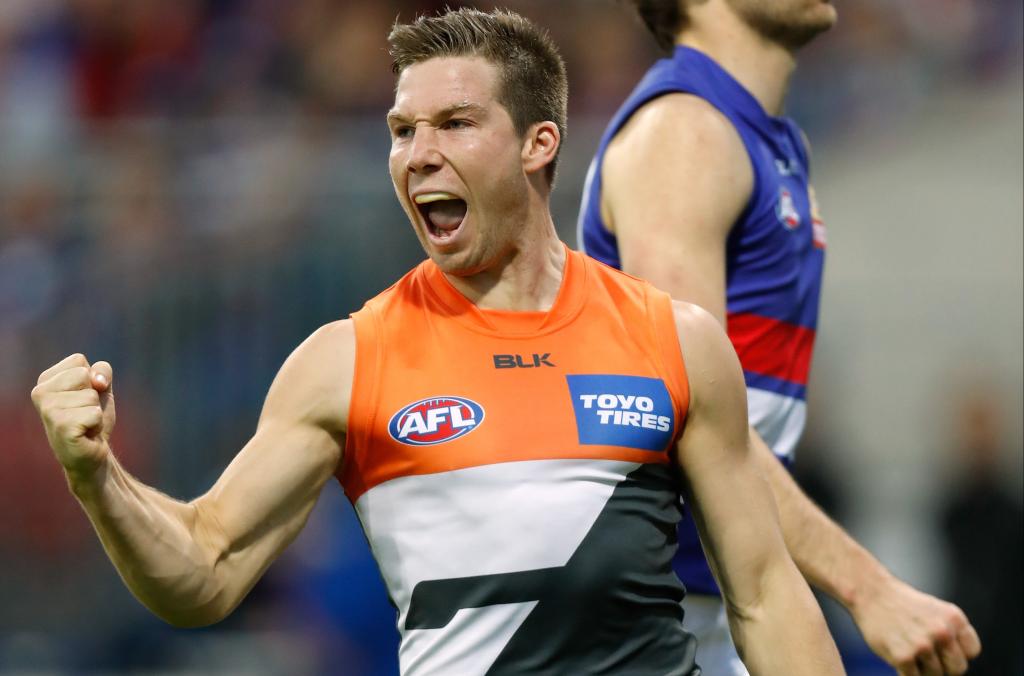
He formed a lethal partnership with veteran Steve Johnson that season as the Giants made it to the preliminary final and looked to be settled as a forward for good.
Greene backed up his breakout season with 45 goals in 2017 and while injuries ruined his output the following year, he remains a must-watch star whenever he's fit and healthy, and arguably the Giants' most important player. – Adam Curley
| Season | Goals | Goal assists | Inside 50s |
| 2015 | 15 | 16 | 79 |
| 2016 | 44 | 28 (1st in AFL) | 122 (3rd in AFL) |
Brett Ratten, 1995
Brett Ratten had spent the first five years of his Carlton career as a stopper in the back pocket, but enjoyed his breakout season as a permanent midfielder in the side's premiership team.
Playing predominantly on the ball, Ratten's numbers skyrocketed as his midfield minutes increased. Consistently getting first hands on the footy, Ratten was able to use his footy smarts in contested situations to elevate himself as one of the side's most important players throughout its last flag season.
Ratten looks for options against the Bombers in Carlton's last premiership season.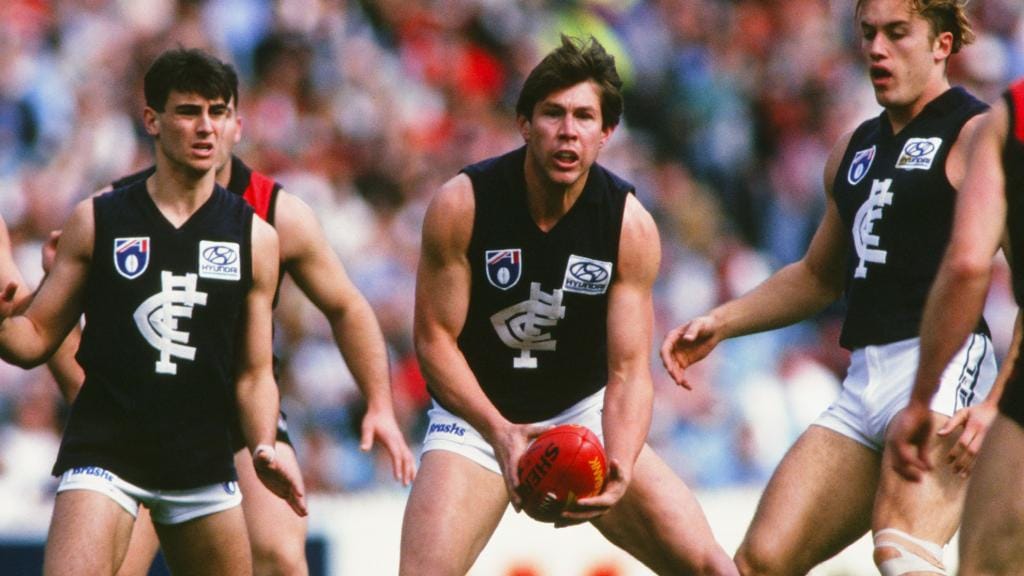
His move into the midfield was pivotal in Carlton achieving premiership success, and the Blues knew it. Despite Ratten not receiving a single Brownlow Medal vote throughout the year, he won the club's best and fairest award.
Among the highlights of Ratten's 1995 campaign was a stellar performance against Fitzroy, where he won personal best numbers of 44 disposals. It kickstarted a career in the midfield that saw him average more than 20 touches per game for the next eight years. – Riley Beveridge
| Season | Games | Avg disposals | Avg tackles | Goals |
| 1994 | 11 | 16.8 | 1.9 | 2 |
| 1995 | 25 | 22.8 | 3.0 | 12 |
Tom Mitchell, 2017
Squeezed out of Sydney at the end of 2016, largely for salary cap purposes, Mitchell made the most of his increased opportunities at his new club.
By round eight of his first season at Hawthorn, Mitchell had accumulated the most disposals of any player in AFL history to that point of a single season. Mitchell finished 2017 with a total of 787 disposals, the fourth-highest tally ever at the time.
The gun recruit quickly became the Hawks' prime ball-winning midfielder – a significant role to fill following the shock departures of Hawks legends Sam Mitchell and Jordan Lewis. In round nine against Collingwood he tallied 50 disposals, kickstarting a feverish debate about how much impact he actually has on games.
Tom Mitchell and the Sherrin were rarely parted in 2017.
Mitchell also became one of the benchmarks in the competition for his work around clearances, on the way to collecting his first Peter Crimmins medal as Hawthorn's best and fairest player. The 24-year-old also placed second in the Brownlow medal in his breakout year, a precursor to 2018 when he took the prestigious award home. – Ben Guthrie
| Season | Disposals | Clearances | Marks | Tackles |
| 2016 | 27.9 | 3.6 | 3.8 | 6.1 |
| 2017 | 35.8 | 6.3 | 5.3 | 6.5 |
Robbie Gray, 2014
Gray struggled to 90 games in his first seven seasons after Port picked him with selection No.55 in the 2006 NAB AFL Draft. Gray showed plenty of promise but was kept from the park by a series of injuries, none more serious than a torn ACL in round four of the 2012 season against Collingwood. At the start of 2013, Gray changed his playing number from No.17 to No.9 – his junior number – and it signalled a fresh start.
On the back of a solid 2013 season, he moved into the midfield the following year and exploded into the AFL's elite.
Gray averaged career-highs in disposals, clearances and kicked 42 goals. He was named the AFL Coaches' Association Champion player of the year and earned All-Australian honours for the first time.
Robbie Gray drops the hips on his way to an explosive breakout season in 2014.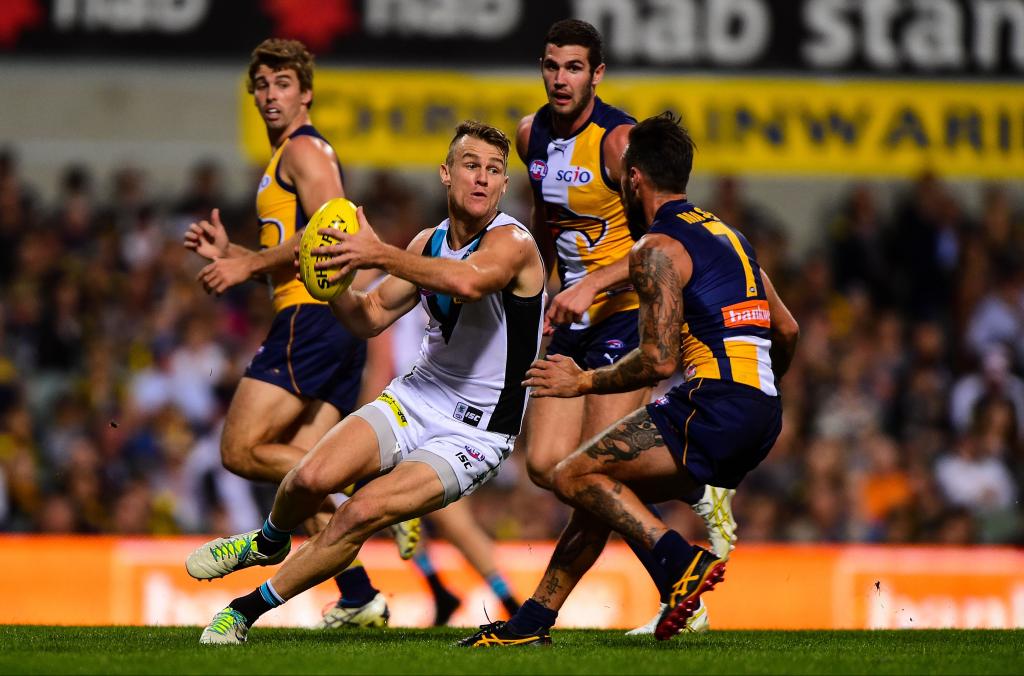
The breakout season established Gray as the most dominant player at the Power. He owned the club's best and fairest for three seasons from 2014-16, and added three more All Australian blazers in 2015, 2017 and 2018. – Lee Gaskin
Gray's honour board now includes four All Australian blazers plus a swag of club best and fairests and Showdown medals.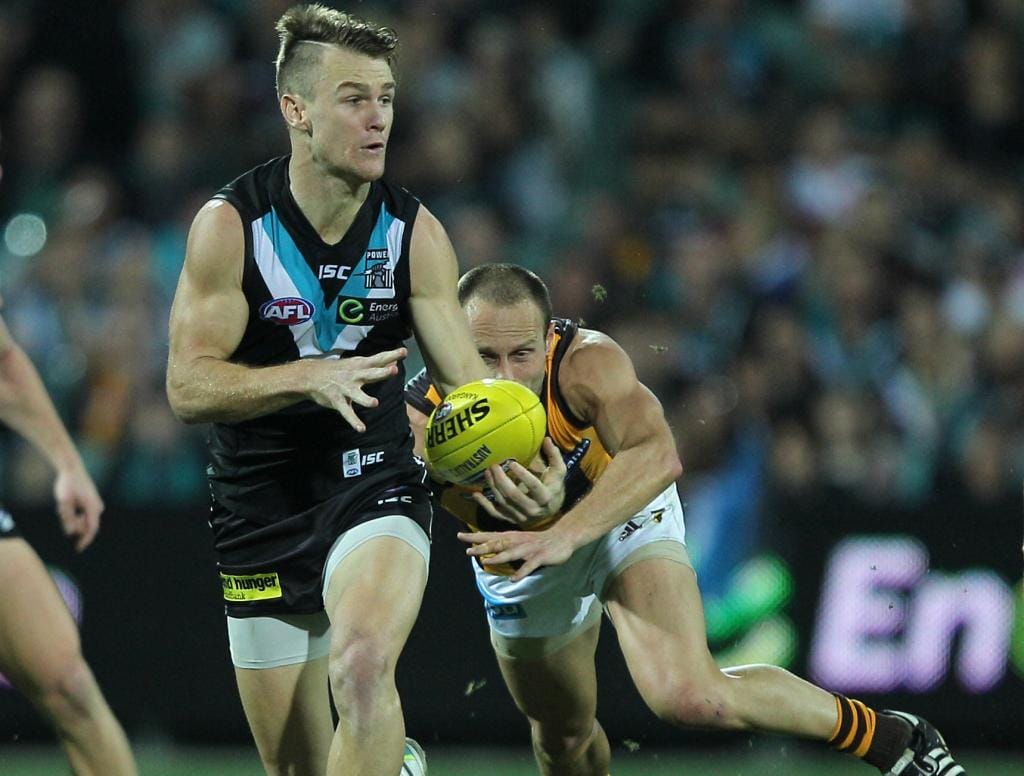
| Season | Disposals | Clearances | Marks | Goals |
| 2013 | 16.9 | 3.2 | 3.1 | 0.8 |
| 2014 | 24.9 | 5.8 | 3.9 | 1.7 |
Read more
KEEP YOUR SCARF ON Is this the coldest footy clinic ever held?
LIGHTS OUT How pre-season footy lost its glamour


